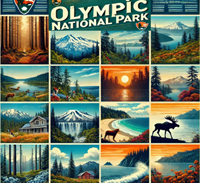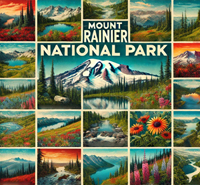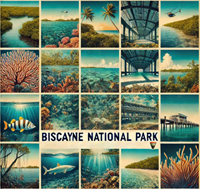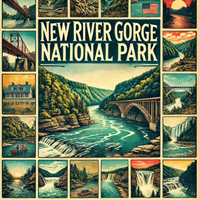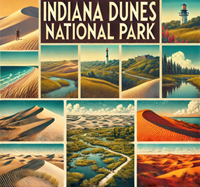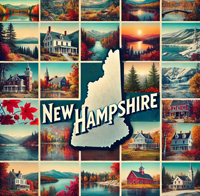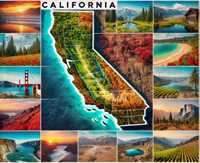

Embark on a journey curated by seasoned explorers William and Hui Cha Stanek, who have spent decades immersing themselves in the diverse landscapes of North America. These itineraries are more than just travel plans - they are thoughtfully crafted adventures designed to help you connect with the natural world, discover hidden gems, and create lasting memories.
National Parks Index | US Itineraries Index | American Roadtrips Index

Bring home a Bugville Critters book and watch as your child's love for reading and learning grows with every page. Hand-painted illustrations bring the heartwarming stories to life. Ask your librarian to add Bugville Critters to the library's digital collection today!
Discover William Stanek's Exclusive Art Collection
Explore and purchase the stunning art featured on this site. Own a piece of William Stanek's unique and captivating artwork today!
(May 2, 2025) Exploring Capitol Reef National Park and Goblin Valley State Park: Utah's Hidden Wonders
Introduction: A 2-Day Journey Through Utah's Hidden Wonders
The red rock landscapes of Utah never fail to draw us back. The vibrant colors, the intricate rock formations, and the sense of timelessness in these ancient lands are like nowhere else on earth. Capitol Reef National Park and Goblin Valley State Park are two of Utah's hidden gems, places where you can experience the beauty of the desert without the crowds that often accompany more famous destinations like Arches or Zion.
Our journey began with an early morning drive along Utah's Scenic Byway 24, a route that winds its way through some of the most spectacular landscapes in the state. The towering cliffs of the Waterpocket Fold, the fertile orchards of Fruita, and the strange, otherworldly formations of Goblin Valley all awaited us, promising a day of adventure and discovery.
Capitol Reef National Park is often described as one of Utah's best-kept secrets. It's a place where the rugged beauty of the desert meets the lush greenery of the Fremont River, creating a landscape that is both striking and serene. The park's central feature, the Waterpocket Fold, is a nearly 100-mile-long wrinkle in the earth's crust, and exploring its canyons, domes, and cliffs is like stepping back in time.
A short drive to the northeast, Goblin Valley State Park offers a completely different experience. Here, the landscape is dotted with thousands of bizarre, mushroom-shaped rock formations that give the valley its name. It's a place that feels almost otherworldly, like something out of a science fiction novel, and it's a fantastic destination for both photography and exploration.
Join us as we take you on a journey through these two remarkable parks. We'll share our stories, tips, and insights to help you create your own unforgettable experiences in Utah's hidden wonders.
Day 1: The Rugged Beauty of Capitol Reef National Park
Morning: Sunrise at Panorama Point
Overview
Start your Capitol Reef adventure with a sunrise at Panorama Point, one of the most accessible and breathtaking viewpoints in the park. This spot offers sweeping views of the Waterpocket Fold, the Henry Mountains, and the rugged cliffs and canyons that make up the heart of Capitol Reef.
Tips from William
"Arrive at Panorama Point by 6:00 AM to catch the first light of the day. The early morning light is perfect for photography, casting a warm glow over the red rock formations and highlighting the textures and details of the landscape. Bring a wide-angle lens to capture the full scope of the view, and a graduated neutral density filter to balance the exposure between the bright sky and the darker foreground."
Insights from Hui Cha
"Panorama Point at sunrise is a truly magical experience. The way the light slowly creeps over the horizon, illuminating the cliffs and canyons, is something you won't forget. Dress warmly, as it can be quite chilly before the sun rises, and bring a thermos of hot coffee or tea to enjoy while you watch the show."
How to Access Panorama Point
Directions:
- From the Capitol Reef Visitor Center, take UT-24 west for about 2 miles, then turn left onto the road to Panorama Point. The parking area is located at the end of the road.
Viewpoint Details:
- Location: About 2 miles west of the Capitol Reef Visitor Center
- Elevation Gain: Minimal
- Difficulty: Easy
Photography Tips: For the best shots of the sunrise, position yourself on the western side of the viewpoint to capture the first light as it hits the cliffs and canyons. Use a small aperture (f/16 or smaller) to keep both the foreground and the distant mountains in focus. A wide-angle lens will allow you to capture the full scope of the landscape, and a tripod is essential for stabilizing your camera in the low light.
Alternative Activity: If the early morning start at Panorama Point is too demanding, consider watching the sunrise from the nearby Sunset Point, which offers equally stunning views of the Waterpocket Fold and the surrounding desert.
Mid-Morning: Exploring the Hickman Bridge Trail
Overview
After the sunrise, head to the Hickman Bridge Trail, one of the most popular hikes in Capitol Reef. This moderate hike takes you through a beautiful canyon to a stunning natural arch that spans 133 feet across and 125 feet high.
Tips from William
"The Hickman Bridge Trail is a great way to experience the beauty of Capitol Reef up close. Bring a wide-angle lens to capture the full scale of the arch, but also keep a telephoto lens handy for zooming in on the details of the rock formations and the surrounding landscape. The light in the late morning is still good for photography, so take your time and enjoy the hike."
Insights from Hui Cha
"This hike offers some of the most beautiful scenery in the park, with the trail winding through a narrow canyon before opening up to reveal the impressive Hickman Bridge. The arch is even more spectacular in person, and I love finding a quiet spot beneath it to sit and take in the beauty of the place."
How to Access the Hickman Bridge Trail
Directions:
- From the Capitol Reef Visitor Center, take UT-24 east for about 2 miles to the Hickman Bridge trailhead, located on the right side of the road.
Trail Details:
- Trail Length: 2 miles round-trip
- Elevation Gain: 400 feet
- Difficulty: Moderate
Photography Tips: For the best shots of Hickman Bridge, arrive mid-morning to catch the soft light as it illuminates the arch. Use a wide-angle lens to capture the full scale of the arch, and experiment with different compositions to highlight the contrast between the arch and the surrounding canyon walls. For a more creative shot, try framing the arch with the desert plants that line the trail.
Alternative Activity: If the hike to Hickman Bridge is too challenging, consider exploring the nearby Grand Wash Trail, a relatively flat and easy hike that takes you through a narrow canyon with towering walls and unique rock formations.
Afternoon: Scenic Drive Through Capitol Reef
Overview
In the afternoon, take a scenic drive through Capitol Reef, exploring the park's diverse landscapes and historic sites. The 8-mile paved road winds through some of the most beautiful scenery in the park, with opportunities to see petroglyphs, orchards, and stunning rock formations.
Tips from William
"The scenic drive through Capitol Reef is a must-do, offering some of the best views in the park. Bring a wide-angle lens to capture the expansive vistas, but also keep a telephoto lens handy for zooming in on the details of the rock formations and the surrounding desert. The best light for photography is in the late afternoon, when the sun is low in the sky and the shadows are long."
Insights from Hui Cha
"This drive is one of my favorite parts of Capitol Reef. The views are absolutely breathtaking, and there's a sense of peace and solitude here that's hard to find anywhere else in the park. I love stopping at the various pullouts to take in the scenery and explore the historic sites along the way."
How to Access the Scenic Drive
Directions:
- From the Capitol Reef Visitor Center, take the Scenic Drive south for about 8 miles to the end of the road.
Drive Details:
- Total Distance: 16 miles round-trip
- Elevation Gain: Minimal (depending on the stops)
- Difficulty: Easy
Photography Tips: Stop frequently along the drive to capture different perspectives of the park's unique landscapes. Use a wide-angle lens to capture the expansive views, and switch to a telephoto lens to zoom in on the details of the rock formations and the petroglyphs. For a more creative shot, try framing the landscape with the historic structures and orchards that dot the area.
Alternative Activity: If you prefer to get out of the car and explore on foot, consider hiking the Cohab Canyon Trail, a 3-mile round-trip hike that offers stunning views of the park's canyons and rock formations.
Evening: Sunset at Capitol Dome
Overview
End your day with a visit to Capitol Dome, one of the most iconic landmarks in Capitol Reef National Park. This towering rock formation, which resembles the dome of the U.S. Capitol building, is a must-see for any visitor to the park.
Tips from William
"Capitol Dome is a fantastic spot to capture the sunset, with wide, sweeping views of the surrounding desert and the dome itself. Set up your tripod well before sunset to find the best angle, and use a wide-angle lens to capture the full scene. A graduated neutral density filter will help balance the exposure between the bright sky and the darker landscape."
Insights from Hui Cha
"Sunset at Capitol Dome is one of the most beautiful experiences you can have in Capitol Reef. The way the light plays across the rock, casting long shadows and turning the dome a deep red, is truly magical. Bring a blanket and a warm drink, and take some time to simply sit and enjoy the moment."
How to Access Capitol Dome
Directions:
- From the Capitol Reef Visitor Center, take UT-24 east for about 3 miles to the Capitol Dome parking area, located on the left side of the road.
Viewpoint Details:
- Location: About 3 miles east of the Capitol Reef Visitor Center
- Elevation Gain: None (viewpoint is accessible by car)
- Difficulty: Easy
Photography Tips: For a stunning sunset shot, position yourself on the western side of the viewpoint to capture the last light of the day as it illuminates the dome. Use a small aperture (f/16 or smaller) to keep the entire scene in focus, and experiment with different shutter speeds to capture the changing light. If the conditions are right, consider staying after sunset to photograph the stars as they appear.
Alternative Activity: If you prefer a less crowded spot for sunset, consider visiting the nearby Goosenecks Overlook, which offers equally stunning views of the canyon and the surrounding desert.
Conclusion: Reflections on the Day
As the last rays of sunlight faded from the sky and the stars began to emerge, Hui Cha and I stood quietly at Capitol Dome, reflecting on the incredible journey we had just experienced. From the breathtaking sunrise at Panorama Point to the peaceful sunset over Capitol Dome, each moment had been a reminder of the sheer power and beauty of Capitol Reef National Park.
These moments, spent in the heart of nature, are what make our travels so meaningful. They're a reminder of the importance of preserving these wild places, and of the deep connection we feel to the land. As we packed up our gear and prepared to head back to our campsite, I felt a deep sense of gratitude for the day's experiences and for the time spent in this incredible park.
Our journey through Utah's hidden wonders was far from over. Tomorrow would take us to Goblin Valley State Park, where we would explore a landscape that feels like it belongs on another planet. But for now, we were content to sit beneath the stars, listening to the quiet of the desert and feeling the peace that only comes from being in the heart of the wilderness.
Day 2: The Otherworldly Landscape of Goblin Valley State Park
Morning: Sunrise at the Valley of Goblins
Overview
Begin your day in Goblin Valley State Park with a sunrise at the Valley of Goblins, the park's most famous and surreal landscape. This area is filled with thousands of strange, mushroom-shaped rock formations that resemble goblins, giving the valley its name.
Tips from William
"Arrive at the Valley of Goblins by 6:00 AM to catch the first light of the day. The early morning light is perfect for photography, casting a warm glow over the goblins and highlighting the textures and details of the formations. Bring a wide-angle lens to capture the full scope of the view, and a graduated neutral density filter to balance the exposure between the bright sky and the darker foreground."
Insights from Hui Cha
"Watching the sunrise over the Valley of Goblins is like watching the start of a new day on another planet. The strange shapes and shadows create an almost eerie atmosphere, and the way the light changes the landscape is truly mesmerizing. Dress warmly, as it can be quite chilly before the sun rises, and bring a thermos of hot coffee or tea to enjoy while you explore."
How to Access the Valley of Goblins
Directions:
- From the Goblin Valley Visitor Center, take the main park road south for about 1 mile to the Valley of Goblins parking area.
Viewpoint Details:
- Location: About 1 mile south of the Goblin Valley Visitor Center
- Elevation Gain: Minimal
- Difficulty: Easy
Photography Tips: For the best shots of the goblins, position yourself on the eastern side of the valley to capture the first light as it hits the formations. Use a small aperture (f/16 or smaller) to keep both the foreground and the distant formations in focus. A wide-angle lens will allow you to capture the full scope of the landscape, and a tripod is essential for stabilizing your camera in the low light.
Alternative Activity: If the early morning start at the Valley of Goblins is too demanding, consider watching the sunrise from the nearby Goblin's Lair, a large cavern located on the eastern edge of the park. The light filtering into the lair creates a magical atmosphere that's perfect for photography.
Mid-Morning: Exploring Goblin's Lair
Overview
After the sunrise, head to Goblin's Lair, a hidden cavern on the eastern edge of Goblin Valley. This short but adventurous hike takes you through the heart of the park's goblin-filled landscape and into a large, open cavern that offers a cool and shady retreat from the desert sun.
Tips from William
"Goblin's Lair is a unique and rewarding hike, offering a different perspective on Goblin Valley. Bring a wide-angle lens to capture the full scale of the lair, but also keep a telephoto lens handy for zooming in on the details of the rock formations and the surrounding landscape. The light in the late morning is still good for photography, so take your time and enjoy the hike."
Insights from Hui Cha
"This hike is one of my favorites in Goblin Valley. The lair itself is a cool and quiet place, with the walls rising high above you and the light filtering in through cracks in the ceiling. It's a great place to escape the heat of the day and enjoy the beauty of the park in a more secluded setting."
How to Access Goblin's Lair
Directions:
- From the Valley of Goblins parking area, follow the trail south for about 1 mile to the entrance of Goblin's Lair.
Trail Details:
- Trail Length: 2 miles round-trip
- Elevation Gain: 300 feet
- Difficulty: Moderate
Photography Tips: For the best shots of Goblin's Lair, arrive mid-morning to catch the soft light as it filters into the cavern. Use a wide-angle lens to capture the full scale of the lair, and experiment with different compositions to highlight the contrast between the light and shadows. For a more creative shot, try framing the lair with the surrounding goblins and rock formations.
Alternative Activity: If the hike to Goblin's Lair is too challenging, consider exploring the Curtis Bench Trail, a relatively flat and easy hike that offers beautiful views of the park's unique rock formations and the surrounding desert.
Afternoon: Exploring the Valley of the Goblins
Overview
In the afternoon, return to the Valley of Goblins to explore the park's namesake formations up close. The valley is filled with thousands of goblin-like rock formations, offering endless opportunities for exploration and photography.
Tips from William
"The Valley of Goblins is a photographer's dream, with endless opportunities to capture the unique shapes and textures of the formations. Bring a wide-angle lens to capture the full scale of the landscape, but also keep a telephoto lens handy for zooming in on the details of the goblins. The best light for photography is in the late afternoon, when the sun is low in the sky and the shadows are long."
Insights from Hui Cha
"Exploring the Valley of Goblins feels like wandering through a giant playground of rock. The shapes and sizes of the goblins are fascinating, and I love finding new and interesting formations around every corner. The valley is a great place to let your imagination run wild and enjoy the beauty of the park."
How to Access the Valley of Goblins
Directions:
- From the Goblin Valley Visitor Center, take the main park road south for about 1 mile to the Valley of Goblins parking area.
Trail Details:
- Trail Length: Variable (explore at your own pace)
- Elevation Gain: Minimal
- Difficulty: Easy
Photography Tips: As you explore the Valley of Goblins, look for opportunities to capture the contrast between the strange rock formations and the deep blue sky. Use a polarizing filter to enhance the colors and reduce glare, especially in the midday sun. For a more creative shot, try framing the goblins with the surrounding desert plants and rock formations.
Alternative Activity: If you prefer a more structured hike, consider exploring the Entrada Canyon Trail, a 4.4-mile round-trip hike that takes you through a beautiful canyon with unique rock formations and stunning views of the surrounding desert.
Evening: Sunset at Wild Horse Butte
Overview
End your day with a visit to Wild Horse Butte, a prominent rock formation on the edge of Goblin Valley. This towering butte offers stunning views of the surrounding desert and is a fantastic spot to watch the sunset.
Tips from William
"Wild Horse Butte is a fantastic spot to capture the sunset, with wide, sweeping views of the surrounding desert and the butte itself. Set up your tripod well before sunset to find the best angle, and use a wide-angle lens to capture the full scene. A graduated neutral density filter will help balance the exposure between the bright sky and the darker landscape."
Insights from Hui Cha
"Sunset at Wild Horse Butte is one of the most beautiful experiences you can have in Goblin Valley. The way the light plays across the butte, casting long shadows and turning the rock a deep red, is truly magical. Bring a blanket and a warm drink, and take some time to simply sit and enjoy the moment."
How to Access Wild Horse Butte
Directions:
- From the Goblin Valley Visitor Center, take the main park road south for about 1 mile, then turn left onto the road to Wild Horse Butte. The parking area is located at the end of the road.
Viewpoint Details:
- Location: About 1 mile south of the Goblin Valley Visitor Center
- Elevation Gain: Minimal (viewpoint is accessible by car)
- Difficulty: Easy
Photography Tips: For a stunning sunset shot, position yourself on the western side of the viewpoint to capture the last light of the day as it illuminates the butte. Use a small aperture (f/16 or smaller) to keep the entire scene in focus, and experiment with different shutter speeds to capture the changing light. If the conditions are right, consider staying after sunset to photograph the stars as they appear.
Alternative Activity: If you prefer a less crowded spot for sunset, consider visiting the nearby Little Wild Horse Canyon, a popular slot canyon with narrow, winding passages and beautiful rock formations.
Conclusion: A Personal Reflection
As the last rays of sunlight faded from the sky and the stars began to emerge, Hui Cha and I stood quietly at Wild Horse Butte, reflecting on the incredible journey we had just experienced. From the otherworldly landscape of the Valley of Goblins to the peaceful solitude of Goblin's Lair, each moment had been a reminder of the sheer power and beauty of Goblin Valley State Park.
These parks are more than just places to visit – they are places to connect with the natural world, to find peace and inspiration, and to create memories that will last a lifetime. As we packed up our gear and prepared to head back to our campsite, I felt a deep sense of gratitude for the time we had spent in these wild, untamed places. They had not only shown us the beauty of the land but had also brought us closer to each other and to the world around us.
Our journey through Utah's hidden wonders had come to an end, but the experiences we had shared would stay with us forever. And as we drove away from the desert, I knew that we would return, drawn back by the promise of new adventures and the chance to explore even deeper into the heart of this stunning wilderness.

Step into a world of timeless beauty with our premium, oversized hardcover book - crafted for discerning collectors and anyone who values the power of art. Perfect for your coffee table, it's more than just a book; it's a conversation starter, a window into over 30 years of William's visionary photography.
Your Support Matters
Purchasing artwork from William Stanek's collection not only brings beauty into your life but also helps us continue to share. Thank you for supporting our creative journey!

Support The Lights of Paris by Robert Stanek, William Stanek's pen name! Through vivid historical detail and deeply moving character stories, Robert takes readers on an unforgettable journey through one of history’s most transformative times.


